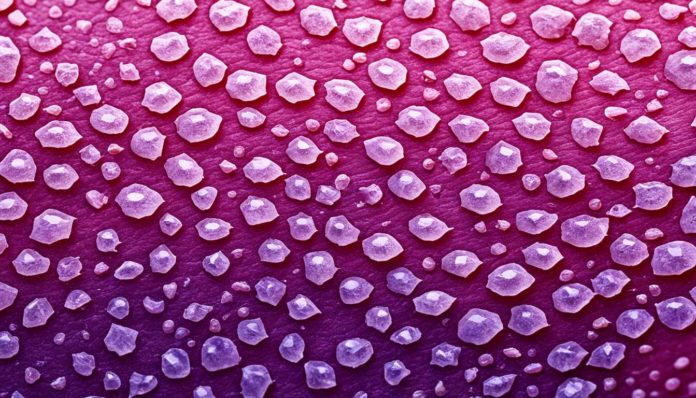Did you know that nearly half of all adults will develop skin tags at some point? These small, benign growths are quite common. Yet, many of us have questions about where they come from and how to get rid of them. In this guide, we’ll explore the different skin tag causes. We’ll also look at the best skin tag removal options, from DIY methods to professional help.
Key Takeaways
- Skin tags are benign skin growths that affect nearly half of adults.
- They can appear in commonly irritated areas such as the neck, underarms, and groin.
- Potential skin tag causes include genetic factors, environmental triggers, and hormonal changes.
- Removal options range from home remedies to professional treatments.
- Maintaining a healthy skincare routine can help in preventing future skin tags.
What are Skin Tags?
Skin tags are harmless growths on the skin. They can show up many places on the body. It’s important to know about them for effective Skin Tag Treatment.

Definition and Characteristics
Skin tags are small, soft pieces of skin. You might see them on the neck, armpits, groin, or under the breasts. They can be tiny or quite large, and their color may vary.
Their surface can be smooth or wrinkly. Even though they look odd, skin tags don’t usually hurt. But, they can get irritated by clothes or jewelry.
Common Locations on the Body
Skin tags often appear where skin rubs together. This includes places like:
- Neck
- Armpits
- Eyelids
- Under the breasts
- Groin folds
- Upper chest
Knowing where skin tags tend to form helps spot them early. Skin Tag Treatment is easier then. If skin tags bother you, a doctor can help.
Causes of Skin Tags
Skin tags grow due to different reasons, including heredity and environment. Hormonal changes also play a part. Understanding these causes is key to control and maybe even prevent them.

Genetic Factors
A family history of skin tags might mean you’re more likely to get them. It’s crucial to know about genetic links. This knowledge helps in grasping why skin tags appear.
Environmental Triggers
Things like skin rubbing from tight clothes or jewelry can lead to skin tags. These are environmental triggers. Knowing this allows for steps to be taken to lessen their formation.
Hormonal Influences
Changes in hormones, especially during pregnancy or imbalances, make skin tags more likely. It shows the complexity of their causes. Keeping an eye on hormonal health might help manage them.
How to Get Rid of Skin Tags: Home Remedies
Looking for how to get rid of skin tags points you to various natural fixes. These methods are cheap and often ready to use at home. This makes them an easy pick for many.
Tea Tree Oil
One top choice for skin tag home remedies is tea tree oil. This oil is known for its antiviral, antifungal, and antiseptic traits. It offers a safe method to remove skin tags.
- Clean and dry the target area carefully.
- Put some *tea tree oil* on a cotton ball.
- Fix the cotton ball on the skin tag with a bandage.
- Keep it on overnight and do this each day until the skin tag drops off.
Be cautious as tea tree oil might irritate some people. Always do a patch test first.
Apple Cider Vinegar
Apple cider vinegar also works well for how to get rid of skin tags. Its acid slowly dissolves the skin tag tissue.
- Drench a cotton ball in apple cider vinegar.
- Put the wet cotton ball on the skin tag.
- Hold it with a bandage for 20-30 minutes.
- Clean the spot with soap and water.
- Repeat daily until the skin tag is gone.
Important: Don’t use apple cider vinegar on delicate skin parts. Its high acid can cause burns or irritation.
Other Over-the-Counter Solutions
Besides skin tag home remedies like tea tree oil and apple cider vinegar, there are handy store-bought options.
| Solution | Description | Usage |
|---|---|---|
| Skin Tag Removal Creams | Creams with plant extracts and minerals | Use twice daily as the product suggests |
| Skin Tag Freezing Kits | Freezing the skin tag with cryotherapy | Use as per the kit’s guide |
Whether going for skin tag home remedies or store options, sticking to the routine and applying correctly is crucial for success.
Professional Skin Tag Removal Options
If home remedies don’t work, seeing a dermatologist for skin tag removal is smart. These methods are precise, effective, and safe.
Cryotherapy
Cryotherapy uses liquid nitrogen to freeze off the skin tag. It’s a fast and effective way with little pain. There’s a small recovery time and almost no scarring.
Laser Removal
Laser removal uses light to remove skin tags. It’s good for getting rid of many tags at once. The recovery is quick, making it a great choice.
Surgical Excision
Surgical excision is best for big skin tags. A dermatologist cuts off the tag with a scalpel. It may need local anesthetic, but healing is easy and scars are rare.
Skin Tag Prevention: Tips and Strategies
Many aim to prevent skin tags, especially those who often get them. Changing your skincare routine and leading a healthy lifestyle can greatly reduce these harmless skin growths.
Skincare Routine Adjustments
Changing your skincare routine helps avoid skin tags. Here are useful tips:
- Minimize friction: Repeated friction from clothes or jewelry can cause skin tags. Choose loose clothing and non-irritating accessories.
- Hydrate the skin: Keeping your skin moist reduces skin tag formation. Select moisturizers that don’t clog pores and match your skin type.
- Cleanse gently: Avoid strong cleansers that remove natural skin oils. Gentler options can prevent irritation and skin tags.
Healthy Lifestyle Choices
A healthy lifestyle is key in skin tag prevention. Here are some tips to follow:
- Maintain healthy weight: Being overweight can create skin folds, inviting skin tags. Eating right and exercising can control your weight.
- Balanced blood sugar levels: High blood sugar, as found in diabetes, can raise skin tag risk. Keep your blood sugar in check to lessen this risk.
- Stay hydrated: Drinking lots of water benefits your skin, making it less prone to skin tags.
Risks and Complications of Removing Skin Tags
Getting rid of skin tags can make you feel better and look better. But, it’s key to know about skin tag removal risks. Even with an expert doing the work, complications can happen. It’s vital to be well-informed.
Bleeding and infection are common when removing skin tags. Bleeding mostly happens if the method used is wrong. Infections could arise if the site isn’t kept sterile before and after the procedure. This points out why it’s safer to go to a pro than to try DIY or store-bought fixes.
Scarring is another risk to think about. Small skin tags tend to heal with hardly any scars. Yet, if not done right, you might get big and visible scars. This happens more to those with delicate skin or who easily scar.
Sometimes, removing a skin tag can uncover other issues or growths. Diagnoses like neurofibromatosis type 1, genital warts, and seborrheic keratosis might look like skin tags. But they need different care.
Below is a table comparing the complications based on how skin tags are removed:
| Removal Method | Common Complications | Notes |
|---|---|---|
| Snip Excision | Bleeding, Infection, Scarring | Performed with surgical scissors; requires aseptic technique. |
| Cryotherapy | Blistering, Skin Discoloration | Freezing off skin tags can lead to temporary skin discoloration. |
| Radio Cautery | Minor Burns, Infection | Burns off skin tags using electric current; needs precise application. |
In short, removing skin tags has its benefits. Yet, knowing the skin tag removal risks is crucial. Talking to a healthcare pro will guide you to a safe skin tag treatment.
When to Consult a Dermatologist
Knowing when to get medical advice for skin tags is key for your skin’s health. While many skin tags are harmless, some symptoms might mean you need a pro’s look. Spotting these signs early can prevent problems and get you the help you need fast.
Signs of Infection
Seeing any signs of infection around a skin tag? See a dermatologist right away. Symptoms like redness, swelling, pus, or warmth could mean an infection. A skin tag expert can offer the right diagnosis and treatment to stop worse issues.
Unusual Growths
It’s important to ask a dermatologist about odd growths. If a skin tag changes quickly in size, shape, color, or feel, it might be a worry. Getting advice from a dermatologist for skin tags means suspicious growths are checked and handled right.
Skincare for Skin Tags: Maintaining Healthy Skin
Managing skin tags begins with effective skincare. This ensures your skin stays healthy. We’ll look at essential practices such as proper cleansing, the right products, and ongoing care.
Proper Cleansing Techniques
Gentle cleaning is a key step in keeping your skin healthy, especially with skin tags. Avoid harsh soaps. Mild cleansers help keep your skin hydrated and balanced.
By cleansing regularly, you keep clean and lower infection risks. This is vital around skin tag areas.
Choosing the Right Products
Choosing the right skincare products is crucial. Look for items made for skin health around skin tags. Use products with natural ingredients like tea tree oil for its antimicrobial benefits.
Go for non-comedogenic and fragrance-free options to avoid irritation. For skin tag removal tips, check out this guide.
Ongoing Monitoring and Care
Keep an eye on your skin tags for any changes. Stick to your skincare routine daily. Watch out for any strange growths or discomfort.
If a skin tag bothers you or looks infected, see a dermatologist. Staying proactive helps keep your skin healthy while managing skin tags effectively.
Conclusion
This guide took a deep look at skin tags, their causes, and how to remove them. We learned that genetics, the environment, and hormones can all cause skin tags. Knowing this helps us handle these harmless growths better.
For those preferring gentle methods, tea tree oil and apple cider vinegar are good. For a more lasting solution, cryotherapy, laser removal, and cutting them off work well. Each option has its benefits, so choosing depends on what works best for you.
Keeping your skin healthy is key to avoiding skin tags. A good skincare routine and healthy living help a lot. If skin tags keep coming back or look strange, see a skin doctor. They can offer the right advice and treatment.
In the end, balancing prevention, removal, and skin care leads to healthier skin. This approach helps keep your skin in good shape for a long time.
FAQ
What are skin tags?
Skin tags are soft growths that appear on various body parts. They’re found on the neck, underarms, groin, and under the breasts. Though not harmful, they’re connected through a small, thin stalk.
What causes skin tags?
They stem from different causes like genetics, skin rubbing, and hormone shifts. Skin tags often develop where skin touches skin or clothing. People with diabetes or obesity may see them more.
How can I remove skin tags at home?
Removing skin tags at home can be done with tea tree oil or apple cider vinegar. There are also over-the-counter options. Make sure to use them correctly to avoid harming your skin.
What are the professional options for removing skin tags?
Professionals might use cryotherapy, lasers, or surgery to remove skin tags. Each method has upsides and possible negatives like healing time and scarring risks.
Are there risks associated with skin tag removal?
Yes, risks include possible infections or scars. Always use safe methods and think about seeing a doctor for advice, especially with home treatments.
How can I prevent skin tags from forming?
Reducing skin friction helps prevent skin tags. Wear loose clothes and care for your skin. Staying healthy and monitoring blood sugar can also lower skin tag chances.
When should I see a dermatologist for skin tags?
If a skin tag gets infected or changes, see a dermatologist. Watch for redness, swelling, or color and shape shifts. A doctor’s check is crucial then.
What are proper skincare techniques for managing skin tags?
Use the right cleansing methods and skincare products. Keep an eye on any changes in your skin tags. This helps avoid irritation and keeps your skin healthy.


